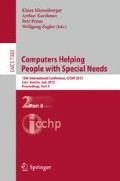Abstract
We investigate tactile representations and haptic interaction that may enable blind people to utilize UML diagrams by using an industry standard editor. In this paper we present a new approach to present tactile UML diagrams by preserving spatial information on a touch-sensitive tactile display. Furthermore we present the results of a fundamental evaluation showing that blind people retain orientation during exploration of tactile diagrams and which problems are associated with the usage of ideographs. We compared our new developed representation with the common method blind people utilize sequence diagrams: non-visually through verbalization. We indicate problems for both representations.
Access this chapter
Tax calculation will be finalised at checkout
Purchases are for personal use only
Preview
Unable to display preview. Download preview PDF.
References
Esmaeili, S.: Transcoder and User Agent for acessible UML diagrams. Diploma thesis, TU Dresden, Dept. Computer Science, Institute for Applied Computer Science (2007) (in German)
Gardner, J., Bulatov, V., Kelly, R.: Making Journals Accessible to the Visually-Impaired –The Future is Near. Learned Publishing 22(4), 314–319 (2009)
Human Performance Research Group: NASA TLX, http://human-factors.arc.nasa.gov/groups/TLX/
Horstmann, M., Lorenz, M., Watkowski, A., Ioannidis, G., Herzog, O., King, A., Evans, D.G., Hagen, C., Schlieder, C., Burn, A.-M., King, N., Petrie, H., Dijkstra, S., Crombie, D.: Automated interpretation and accessible presentation of technical diagrams for blind people. New Review of Hypermedia and Multimedia 10(2), 141–163 (2004)
Jayant, C., Renzelmann, M., Wen, D., Krisnandi, S., Ladner, R., Comden, D.: Automated tactile graphics translation: in the field. In: Proc ASSETS 2007, pp. 75–82. ACM Press (2007)
Kalina, U.: Verbalized UML Diagrams (2006) (in German), http://sonderpaedagogik.bildung.hessen.de/unterstuetzung/blind_sehbehindert/informatik/material/Vuml.doc
King, A., Blenkhorn, P., Crombie, D., Dijkstra, S., Evans, G., Wood, J.: Presenting UML Software Engineering Diagrams to Blind People. In: Miesenberger, K., Klaus, J., Zagler, W.L., Burger, D. (eds.) ICCHP 2004. LNCS, vol. 3118, pp. 522–529. Springer, Heidelberg (2004)
Kraus, M., Völkel, T., Weber, G.: An Off-Screen Model for Tactile Graphical User Interfaces. In: Miesenberger, K., Klaus, J., Zagler, W.L., Karshmer, A.I. (eds.) ICCHP 2008. LNCS, vol. 5105, pp. 865–872. Springer, Heidelberg (2008)
Müller, K.: How to Make Unified Modeling Language Diagrams Accessible for Blind Students. In: Schult, C., et al. (eds.) ICCHP 2012, Part I. LNCS, vol. 7382, pp. 186–190. Springer, Heidelberg (2012)
Parkes, D.: Nomad: An audio-tactile tool for the aquisition, use and management of spatially distributed information by visually impaired people. In: Proc. Second International Symposium on Maps and Graphics for Visually Handicapped People, pp. 24–29. A.F & Dodds, London (1988)
Prescher, D., Weber, G., Spindler, M.: A Tactile Windowing System for Blind Users. In: Proc. Assets 2010, pp. 91–98. ACM Press (2010)
HyperBraille - The graphics-enabled display for blind computer users, http://www.hyperbraille.de
Rational Software, e.t.al.: UML Summary. OMG document ad/97-08-03 (1997)
Spindler, M., Kraus, M., Weber, G.: A Graphical Tactile Screen-Explorer. In: Miesenberger, K., Klaus, J., Zagler, W., Karshmer, A. (eds.) ICCHP 2010. LNCS, vol. 6180, pp. 474–481. Springer, Heidelberg (2010)
Author information
Authors and Affiliations
Editor information
Editors and Affiliations
Rights and permissions
Copyright information
© 2012 Springer-Verlag Berlin Heidelberg
About this paper
Cite this paper
Loitsch, C., Weber, G. (2012). Viable Haptic UML for Blind People. In: Miesenberger, K., Karshmer, A., Penaz, P., Zagler, W. (eds) Computers Helping People with Special Needs. ICCHP 2012. Lecture Notes in Computer Science, vol 7383. Springer, Berlin, Heidelberg. https://doi.org/10.1007/978-3-642-31534-3_75
Download citation
DOI: https://doi.org/10.1007/978-3-642-31534-3_75
Publisher Name: Springer, Berlin, Heidelberg
Print ISBN: 978-3-642-31533-6
Online ISBN: 978-3-642-31534-3
eBook Packages: Computer ScienceComputer Science (R0)

